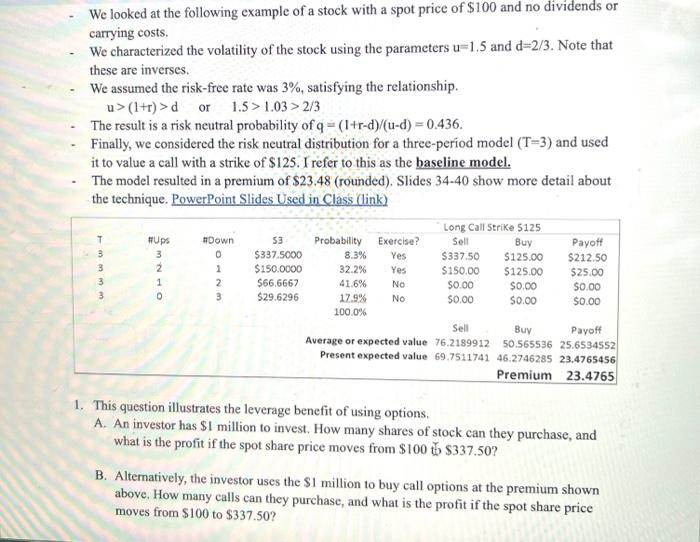please answer all question parts based on the info given
- We looked at the following example of a stock with a spot price of $100 and no dividends or carrying costs. - We characterized the volatility of the stock using the parameters u=1.5 and d=2/3. Note that these are inverses. - We assumed the risk-free rate was 3%, satisfying the relationship. u>(1+r)>dor1.5>1.03>2/3 - The result is a risk neutral probability of q=(1+rd)/(ud)=0.436. - Finally, we considered the risk neutral distribution for a three-period model (T=3) and used it to value a call with a strike of $125. I refer to this as the baseline model. - The model resulted in a premium of $23.48 (rounded). Slides 3440 show more detail about the technique. PowerPoint Slides Used in Class (link) 1. This question illustrates the leverage benefit of using options. A. An investor has \$1 million to invest. How many shares of stock can they purchase, and what is the profit if the spot share price moves from $100 to $337.50 ? B. Alternatively, the investor uses the $1 million to buy call options at the premium shown above. How many calls can they purchase, and what is the profit if the spot share price moves from $100 to $337.50 ? This question illustrates the risk of using options. A. An investor has $1 million to invest. How many shares of stock can they purchase, and what is the profit if the spot share price moves from $100 to $120 ? Note that the price increased, but the call is still out of the money. B. Alternatively, the investor uses the $1 million to buy call options at the premium shown above. How many calls can they purchase, and what is the profit if the spot share price matyes from $100 to $120 ? This question illustrates the use of the model to value different derivative structures. A. Start with the baseline model and determine the premium on a call with a strike of $160. Explain why the premium declines as the call strike increases. B. Start with the baseline model and determine the premium on a put with a strike of $160. Explain why the premium on the put is so much higher than the call's. There are other option structures. For example, consider a binary option that pays off only if the stock price ends up higher than today. The initial spot share price is S8=$100. If the price at time T=3 is higher than $100, you receive $50; if not, you receive 0 . Use the baseline model to determine the premium on the binary options. Extend the baseline model to four periods. There will now be five possible prices and a probability of each. Use the revised model to value a call with a strike of $125








